Biography
Early Life
Benjamin David Goodman was born on May 30, 1909 in Chicago, Illinois. He was the ninth child of immigrants David Goodman and Dora Grisinsky Goodman, who left Russia to escape anti-Semitism. Benny’s mother never learned to speak English. His father worked for a tailor to support his large family, which eventually grew to include a total of 12 children and had trouble making ends meet.
When Benny was 10 years old, his father sent him to study music at Kehelah Jacob Synagogue in Chicago. There, Benny learned the clarinet under the tutelage of Chicago Symphony member Franz Schoepp, while two of his brothers learned tuba and trumpet. He also played in the band at Jane Addams’ famous social settlement, Hull-House.
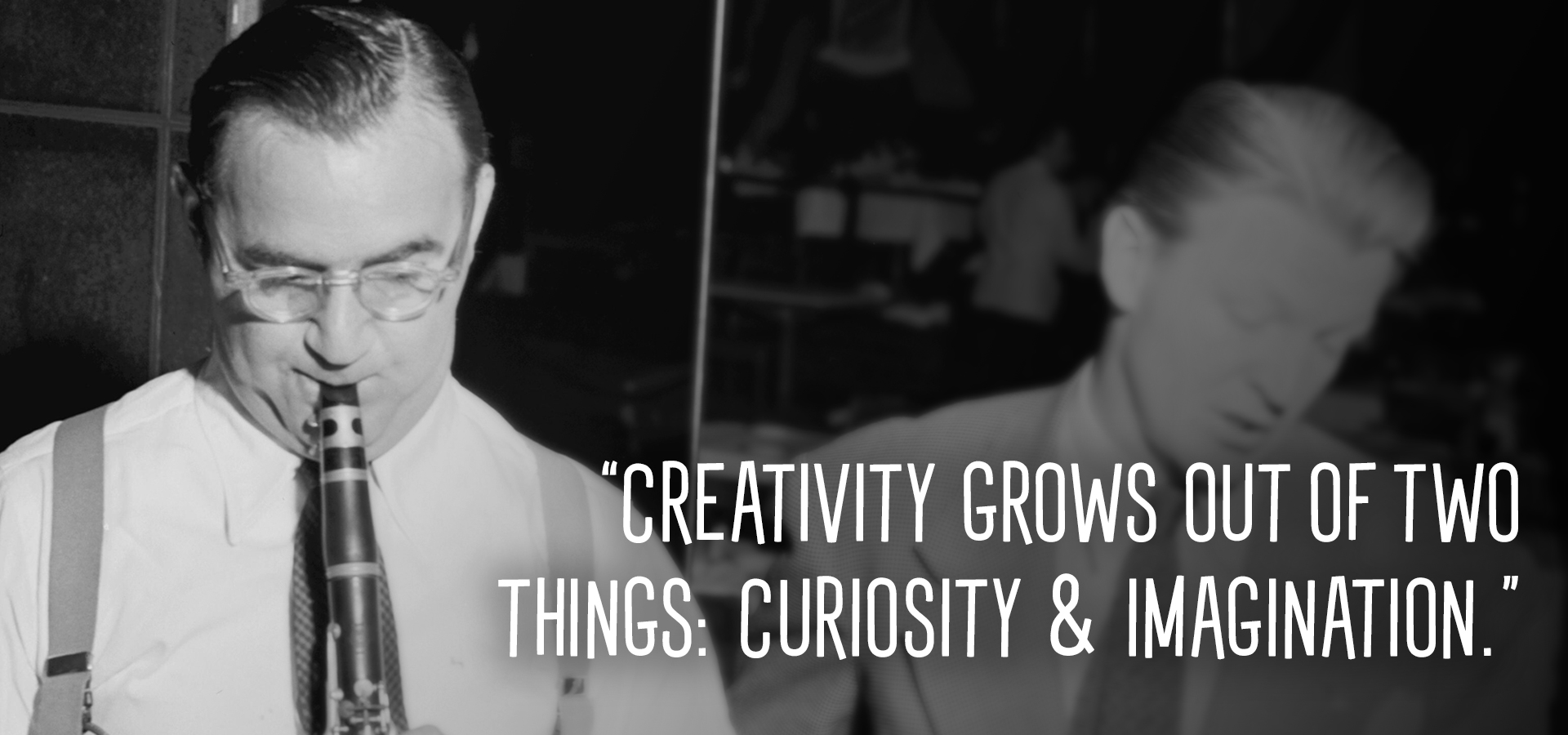
Talent & Success
Benny’s aptitude on the clarinet was immediately apparent. While he was still very young, he became a professional musician and played in several bands in Chicago. He played with his first pit band at the age of 11, and became a member of the American Federation of Musicians when he was 14, when he quit school to pursue his career in music. When his father died, 15-year-old Benny used the money he made to help support his family. During these early years in Chicago, he played with many musicians who would later become nationally renowned, such as Frank Teschemacher and Dave Tough.
When Benny was 16, he was hired by the Ben Pollack Band and moved to Los Angeles. He remained with the band for four years and became a featured soloist. In 1929, the year that marked the onset of the Great Depression and a time of distress for America, Benny left the Ben Pollack Band to participate in recording sessions and radio shows in New York City.
Then, in 1933, Benny began to work with John Hammond, a jazz promoter who would later help to launch the recording careers of Billie Holiday and Count Basie, among many others. Hammond wanted Benny to record with drummer Gene Krupa and trombonist Jack Teagarden, and the result of this recording session was the onset of Benny’s national popularity. Later, in 1942, Benny would marry Alice Hammond Duckworth, John Hammond’s sister, and have two daughters: Rachel, who became a concert pianist, and Benji, who became a cellist.
Benny led his first band in 1934 and began a few-month stint at Billy Rose’s Music Hall, playing Fletcher Henderson’s arrangements along with band members Bunny Berigan, Gene Krupa, and Jess Stacy. The music they played had its roots in the southern jazz forms of ragtime and Dixieland, while its structure adhered more to arranged music than its more improvisational jazz counterparts. This gave it an accessibility that appealed to American audiences on a wide scale. America began to hear Benny‘s band when he secured a weekly engagement for his band on NBC’s radio show Let’s Dance, which was taped with a live studio audience.
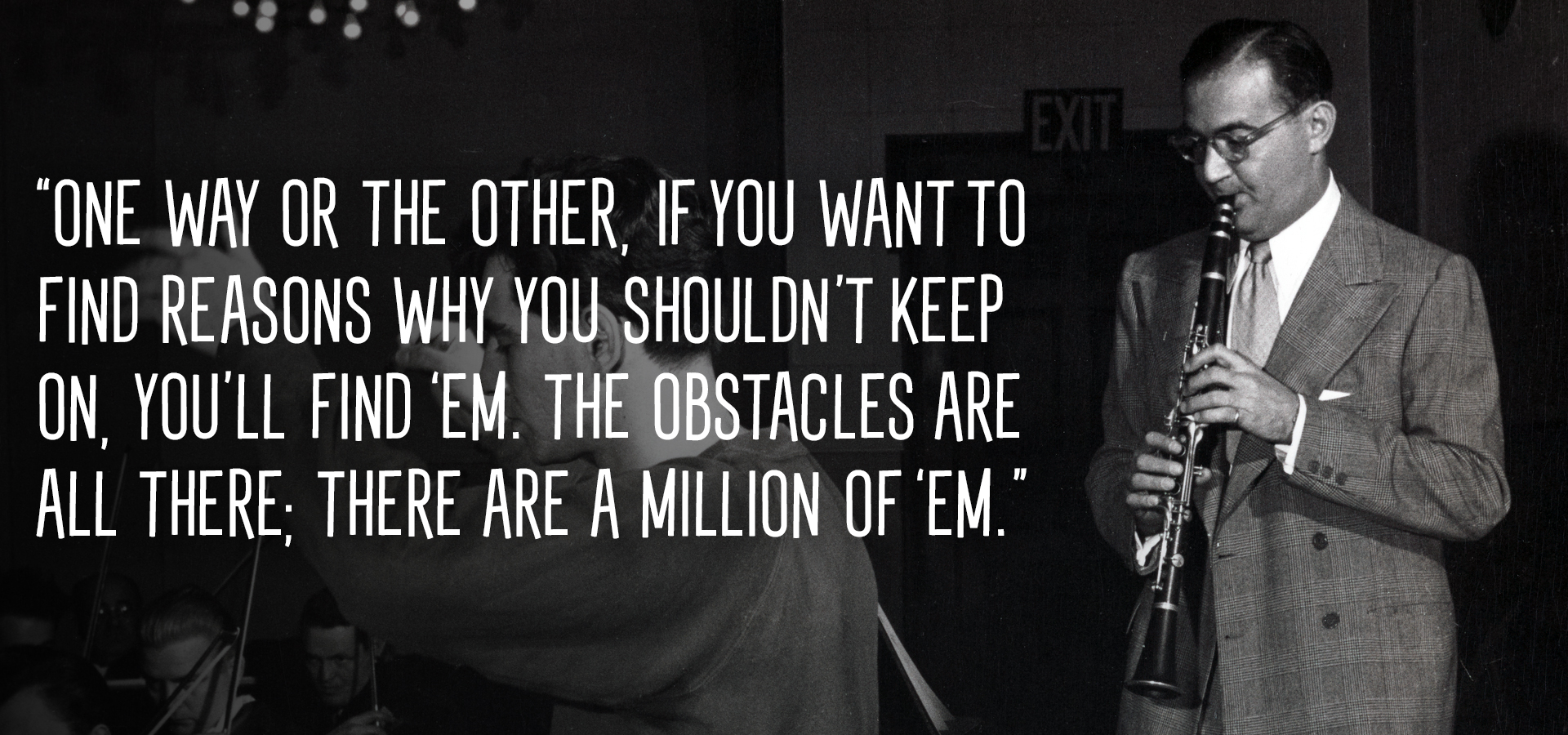
King of Swing
The new swing music had the kids dancing when, on August 21, 1935, Benny’s band played the Palomar Ballroom in Los Angeles. The gig was sensational and marked the beginning of the years that Benny would reign as King: the Swing Era.
Teenagers and college students invented new dance steps to accompany the new music sensation. Benny’s band, along with many others, became hugely successful among listeners from many different backgrounds all over the country.
During this period, Benny also became famous for being colorblind when it came to racial segregation and prejudice. Pianist Teddy Wilson, an African American, first appeared in the Benny Goodman Trio at the Congress Hotel in 1935. Benny added Lionel Hampton, who would later form his own band, to his Benny Goodman Quartet the next year. While these groups were not the first bands to feature both white and black musicians, Benny’s national popularity helped to make racially mixed groups more accepted in the mainstream. Benny once said, “If a guy’s got it, let him give it. I’m selling music, not prejudice.”
Benny’s success as an icon of the Swing Era prompted Time magazine in 1937 to call him the “King of Swing.” The next year, at the pinnacle of the Swing Era, the Benny Goodman band, along with musicians from the Count Basie and Duke Ellington bands, made history as the first jazz band ever to play in New York’s prestigious Carnegie Hall.
Following the concert at Carnegie Hall, the Benny Goodman Band had many different lineup changes. Gene Krupa left the band, among others, and subsequent versions of the band included Cootie Williams and Charlie Christian, as well as Jimmy Maxwell and Mel Powell, among others.
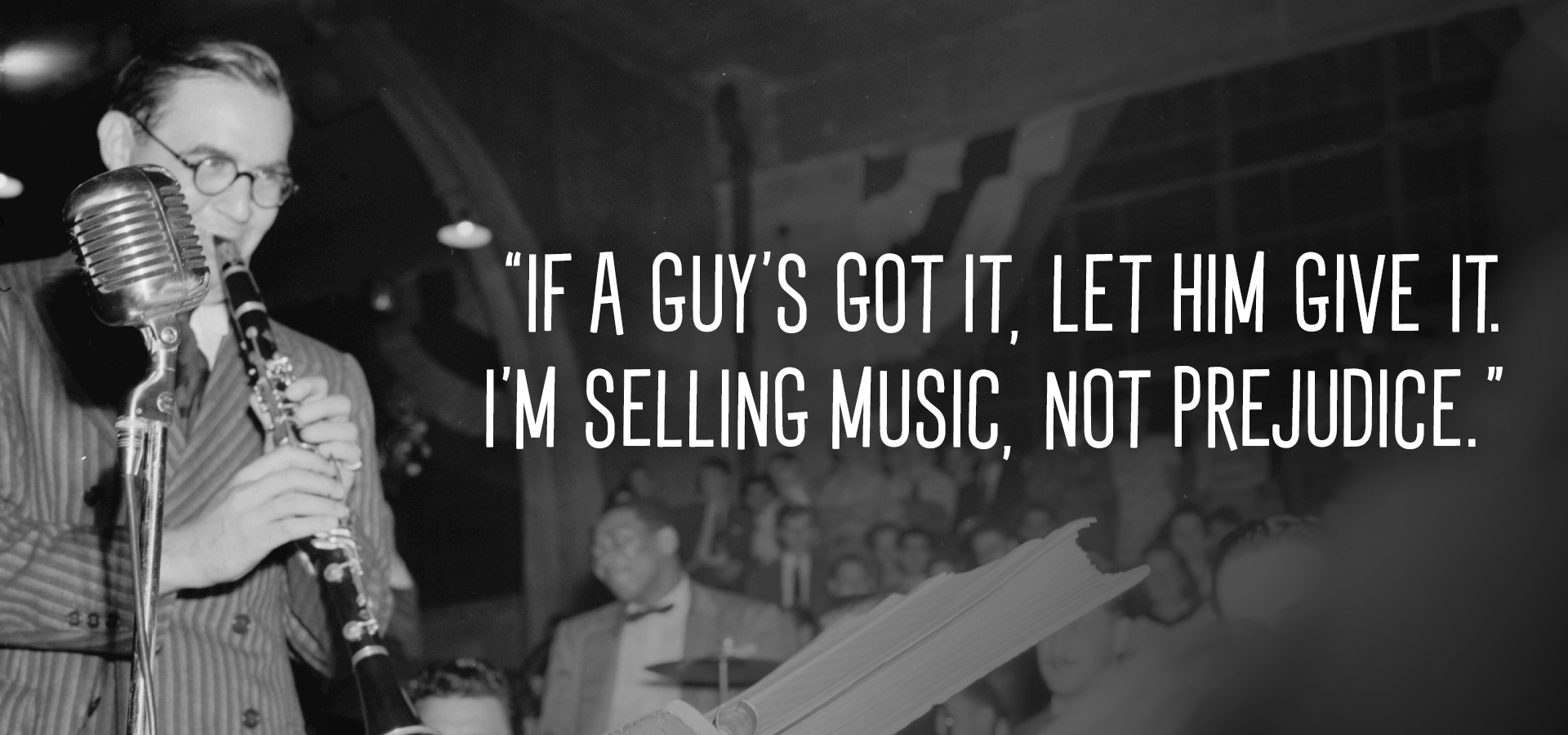
Enduring Icon of the Swing Era
The Swing Era began to come to a close as America got more involved in World War II. Several factors contributed to its waning success, including the loss of musicians to the draft and the limits that gas rationing put on touring bands. However, though the big band days were drawing to a close and new forms of music were emerging, Benny continued to play music in the swing style. He dabbled in the “bop” movement of the 1940s, but never succumbed, as the rest of the world did, to the allure of rock and roll influences in the 1950s and 1960s. Instead, Benny tried his hand at classical music, doing solos with major orchestras, and studying with internationally acclaimed classical clarinetist Reginald Kell.
These appearances further demonstrated Benny’s range as a musician. His talent was unquestionable from the time he was 10 years old, and in recording sessions throughout his career, he very rarely made mistakes. Krell had helped him to improve some of his techniques, making Benny’s playing even stronger.
In 1953, Benny’s band planned to join Louis Armstrong and his All Stars in a tour together, but the two band leaders argued and the tour never opened at Carnegie Hall, as had been planned. It is not certain whether the tour was canceled due to Benny’s illness or the conflict between the band leaders. The rest of the decade marked the spread of Benny’s music to new audiences around the world. The Benny Goodman Story, a film chronicling his life, was released in 1955, exposing new and younger audiences to his music. Benny also toured the world, bringing his music to Asia and Europe. When he traveled to the USSR, one writer observed that “the swing music that had once set the jitterbugs dancing in the Paramount aisles almost blew down the Iron Curtain.”
During the late 1960s and 1970s, Benny appeared in reunions with the other members of his quartet: Teddy Wilson, Gene Krupa, and Lionel Hampton. In 1978, the Benny Goodman band also appeared at Carnegie Hall again to mark the 30th Anniversary of when they appeared in the venue’s first jazz concert.
In 1982, Benny was honored by the Kennedy Center for his lifetime achievements in swing music. In 1986, he received both an honorary doctorate degree in music from Columbia University and the Grammy Award for Lifetime Achievement. He continued to play the music that defined his lifetime in occasional concert dates until his death in June 1986 of cardiac arrest. He was laid to rest after a short nonsectarian service with around 40 family members and friends in attendance on June 15, 1986 at Long Ridge Cemetery in Stamford, Connecticut. Through his amazing career, Benny Goodman did not change his style to conform to the latest trends, but retained the original sound that defined the Swing Era and made him the world renowned King of Swing.
Recollections From The Kingdom Of Swing
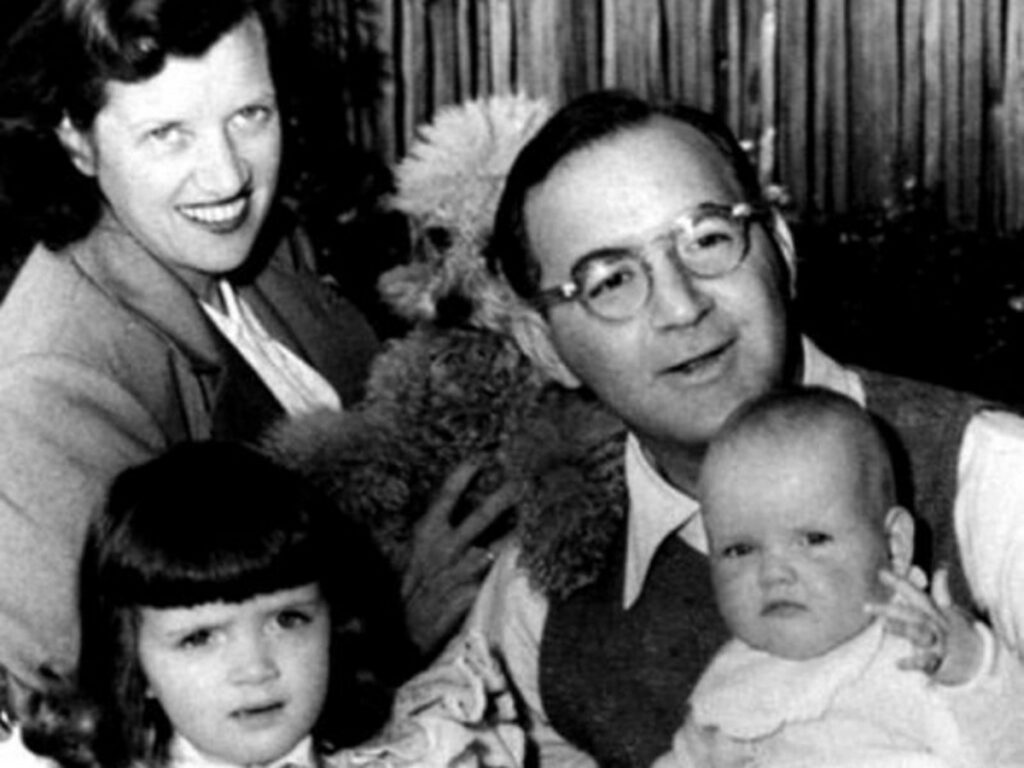
by Rachel Goodman Edelson
BG was a man of a very few words; he was loquacious, articulate, through his clarinet, but generally disinterested in talking. One of his better friends was Old Man Deforest, a woodworker and taciturn Yankee at least twenty years his senior, who lived across the road from us in Stamford, CT, and had who constructed three of the five fireplaces in our 200-hundred-year old house. He and BG took frequent fishing trips, and I can easily picture them saying nothing for days – my father’s idea of a really good time.
He withstood interviews, seeing them only as a necessary evil within the status of celebrityhood. He could stomach the usual range of questions about his childhood, his career, even answer for the thousandth time how it happened that, among his brothers, he got the clarinet: when their father brought them to Hull House for free musical instruments, as the shortest, he naturally was given the shortest instrument. However, he did not take kindly to generalities like, “Benny, where do you think music is heading today?” To this question, he would answer, grimacing slightly, “I have no idea”; even, when exasperated, ”How should I know?”
Nor was he fond of examining alternatives other than the practical (such as whether to have a corned beef or pastrami sandwich). I always remember him finishing the phrase “on the other hand,” said by him or someone else, with “he had warts.”
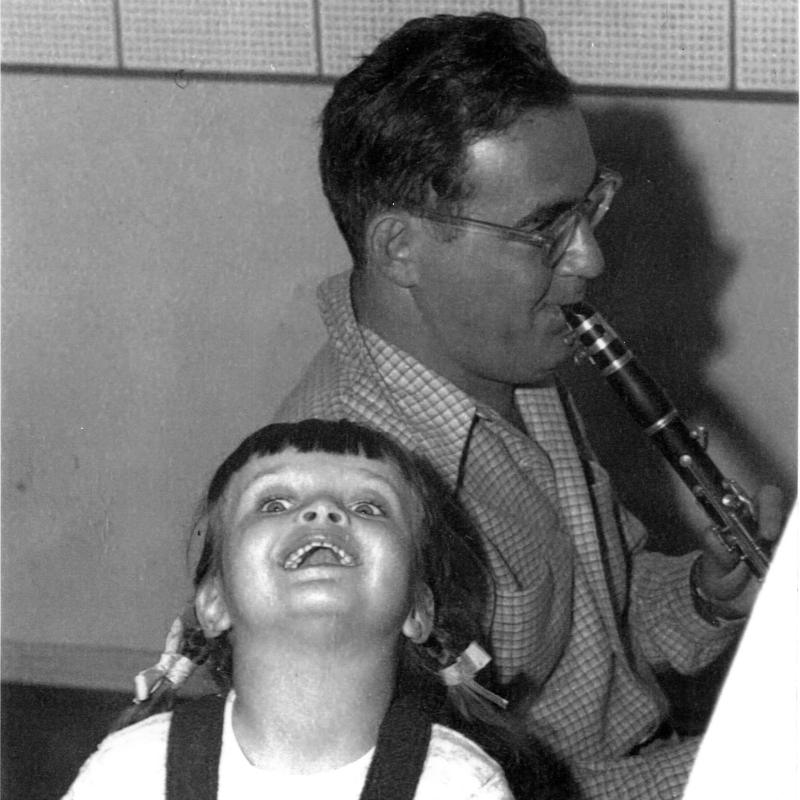
Genius takes many forms; some gifted people can describe clearly what their art form is and how they enact it; others can’t. I’ve learned that there are three kinds of movie directors: A) those who let their actors run with their own performances; B) those who show the actors what they need to do and how to do it; and C) those who will recognize what they want only when they see it, and are clueless in telling their actors how to get there, asking them to do take after take “till they get it right.”
BG’s form of musical tutelage went with Plan C – something I saw in the many times I played classical piano with him or for him in the room we called the studio. It often involved looking faintly pained at the way I was playing something. At least, not looking pleased. I’d ask of a certain phrase or passage that I just played, “How’s this?” He’d answer, equivocally, ”Pretty good,” which meant, “Nope.” What I learned over the years, was that it was useless to ask him for any kind of advice as to phrasing – to help me play a melody of Beethoven or Brahms or whatever classical composer I was working on – so that it would sound as sweet, as moving, as inevitable as the way BG played “Sweet Georgia Brown,” or “Body and Soul.” This form of “teaching” drove me crazy. Sometimes, sitting at my right on the piano bench, he’d attempt to whistle the melody as he wanted to hear it, but only an expert whistler can do justice to a complex classical melody, and BG was an expert clarinetist. Sometimes he’d try playing the melody on the piano, but he didn’t know the keyboard, so he’d wind up crossing one finger over the other in a bizarre way, making the melody even less recognizable than his whistling did. But I’d keep trying, one version and then another, till his face lit up and he’d announce, “Now you’ve got it.” And I’d be happy. Just as I’m sure that the “boys in the band,” as he called them, would be happy, when they finally achieved the correct lilt and tempo in ‘One O’Clock Jump.”
The studio where BG and I practiced, and where he sometimes recorded or gigged with musician buddies at the small parties my parents threw around every two years, was designed by my mother Alice. She was a woman gifted with an expert spatial and architectural sense, who took pride in being able to draw a floor plan of any building she’d set foot in – unlike my father, who she claimed, even after staying in a hotel for a week, would consistently turn the wrong way when exiting the elevator. This music studio, a detached part of our house, maybe 700 square feet, had been the garage. My mother had it converted into a large, high-ceilinged space, where my father could go to be alone, to practice. This wood-paneled room, a Moroccan many-colored glass lamp hanging from its vaulted ceiling, housed our baby grand piano, a long curved sofa, an American antique music stand and high backed chair where BG practiced, the floor around it always strewn with his reeds – in or removed from their periwinkle blue French boxes. In front of the many-paned window overlooking the swimming pool and garden, was a large antique wooden chest housing an LP turn table, receiver, and a motley assortment of jazz and classical 33 records, including BG’s small collection of Verdi operas, whose drama he relished. Opera was relegated to the studio because my mother loathed it, part of her cultured New York background having meant weekly trips to the opera; she asserted that a worst week of her childhood was the one when she had to go twice to Stauss’ Der Rosenkavalier. In the “opposites attract” department, she was pretty disinterested in all music, including Jazz. She would, however, go to a lot of my father’s gigs, where she’d sit and do her knitting. And it was not music that she listened to on her transistor radio (the long defunct version of the iPod), as she happily weeded and planted her gorgeous English garden, but baseball – a passion she developed via BG.
Swing is mysterious. In 1974, I was sitting in, at a rehearsal of BG and his band. When they had finished playing, I walked over to look at their scores of Roll’Em, having never actually seen any of the Fletcher Henderson scores he used. But to my disbelief, I couldn’t find on the score the notes I’d just heard. I felt bamboozled. My solid knowledge of musical notation told me that the page would be a blur of horizontal flags created by the sea of 32nd and 64th notes, the tiny slices of rhythm that topple the music off the beat, hurling it within the Kingdom of Swing. But the tiny rhythmic bits weren’t there: only quarter notes, lolling, bored, on the page. Impossible! I keep peering, expecting my bouncy vision to materialize.
BG was off in the corner, seated on the high stool where his painful back often forced him.
“I don’t get it,” I complained. “How come the notes look like this? This isn’t what you play.”
He was incredulous. “Of course it isn’t. You didn’t know that? Swing can’t be written, you gotta play it. You gotta make it happen.”
That day, it became clear: “I Got Ryhthm,” played as Gershwin notated it on the page, would plod along like “Mary had a little lamb.” Swing is mysterious.
